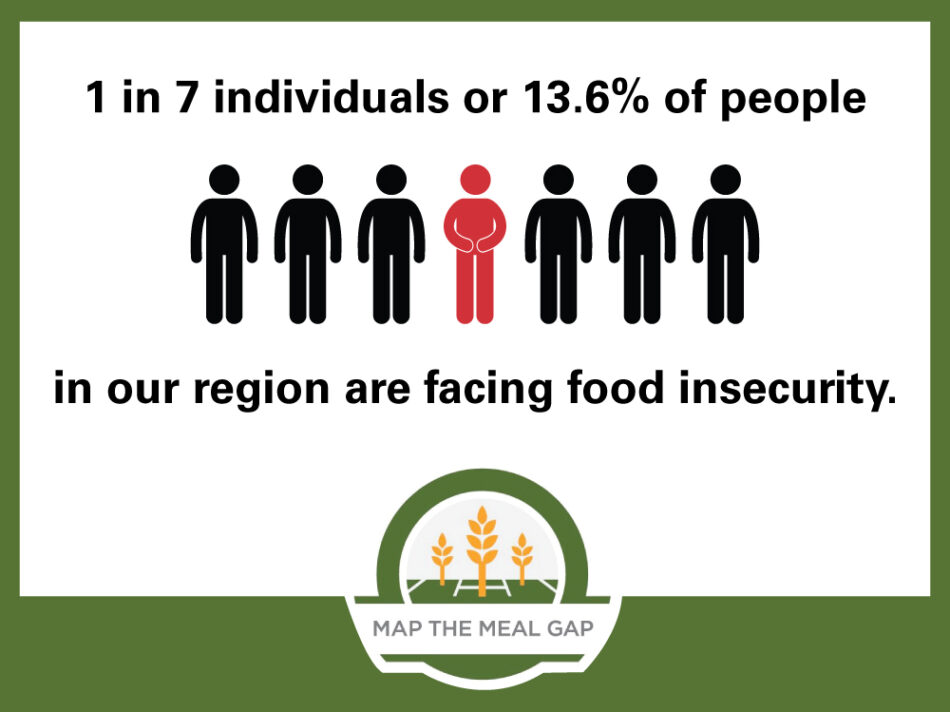
Hunger rates are the highest in a decade according to latest data from Feeding America.
(Kansas City, Mo.) – Harvesters – The Community Food Network, shared sobering news in light of the release of Feeding America’s latest Map the Meal Gap study, which estimates food insecurity down to the county level across the country. According to the study, 1 in 7 (13.6%), or 374,900 individuals in Harvesters’ 27-county region experiences food insecurity. This includes 1 in 6 (17.1%) children, or 110,240 kids. These numbers are the highest in a decade.
“The findings of the Map the Meal Gap Study are disheartening, but they are not surprising” says Stephen Davis, President and CEO of Harvesters. “Our partner agencies have more and more individuals and families seeking food assistance, and we are struggling to keep up. In addition to losing funding and food for some federal nutrition programs, we are receiving fewer donations than normal from both individual and corporate partners in the midst of the current economic climate. We are doing everything we can with the resources we have, but the challenge is great now.”
Today’s data release comes as lawmakers in the US House this week are marking up $290 billion in proposed cuts to the Supplemental Nutrition Assistance Program (SNAP). These cuts, if approved, would among other things, increase the age for work requirements from 55 to 64 and shift some costs of the program to states with already strapped budgets to fund. (In Missouri covering just 10% of SNAP costs would be $150 million and in Kansas it would be $41 million).
The Map the Meal Gap study finds only 37.8% of individuals in Harvesters’ service area experiencing food insecurity currently qualify for SNAP benefits. The other 62.2% do not qualify and are left to find other ways to get by. SNAP currently can provide nine meals for every one meal a food bank provides. Harvesters says it does not have the capacity to make up that difference if cuts are made.
Other notable findings within the Map the Meal Gap study show the Missouri county with the highest rate of food insecurity is Bates County (18.2% total, 22.7% for children). The Kansas county with the highest rate of food insecurity is Riley County (16.3% overall, 22% for children).
Map the Meal Gap, now in its 15th year, is the only study that provides local-level estimates of food insecurity and food costs for every county and congressional district. The study builds upon USDA’s most recent report of national and state data, which showed 47 million people, including 14 million children, experienced food insecurity in 2023.
The study uses publicly available data from USDA Economic Research Service, U.S. Census Bureau and Bureau of Labor Statistics to estimate local food insecurity at the county, congressional district and state levels. The study also estimates local meal costs and food budget shortfalls using food price data from NIQ, based on USDA’s Thrifty Food Plan, and grocery sales tax data for every county and state in the country.
An interactive map that breaks down the food insecurity numbers in greater detail and by county can be found at map.feedingamerica.org. To get involved in filling the hunger gap here at home along with Harvesters, visit harvesters.org.
# # #
About Harvesters—The Community Food Network
Harvesters is a regional food bank serving a 27-county area of northwestern Missouri and northeastern Kansas. Harvesters provides food and related household products to more than 900 nonprofit agencies including food pantries, community kitchens, shelters and others. Pantry partners in Harvesters’ network provide food assistance to as many as 226,000 people each month. Harvesters, which was founded in 1979, is a certified member of Feeding America, a nationwide network of more than 200 food banks, serving all 50 states. For more information, visit www.harvesters.org
